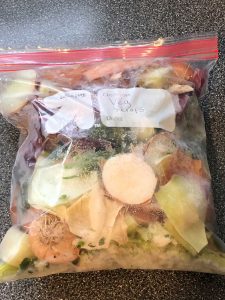Using vegetable broth instead of water is a great way to make dishes more flavorful AND healthful. But store-bought broth is usually high in sodium and expensive. This broth can be made FOR FREE using the scraps of vegetables you usually throw away. Get some extra mileage from your scraps!
For the broth, you'll want to have a gallon-sized zipper bag to keep in the freezer. When you prepare a dish, toss your leftover vegetable scraps in. I'm talking the ends of celery and carrots, vegetable skins, herb and mushroom stems, pepper stems and seeds, tomato tops, spinach, onion ends and skins, etc. Put the bag back in the freezer and when it's full, you're ready to make your broth.
Tips: Avoid strong tasting vegetables whose flavor will take over, like broccoli and cauliflower. Also, make sure everything you toss in the bag is clean and in good shape. A little wilty is ok, but you don't want anything moldy or that wouldn't otherwise be safe to eat. Also, it's helpful to know that the more onion skins you have, the darker your broth will be, so if you want a lighter broth, use less onion skins.

📖 Recipe
Vegetable Broth using Kitchen Scraps
Ingredients
- 1 Gallon Bag Vegetable Scraps (clean and in good shape)
- Water
Instructions
- Add the frozen vegetable scraps to a 10-quart stock pot (or similar size).

- Fill with water, allowing a few inches of boiling room at the top.
- Bring pot to a boil. Reduce to a simmer. Simmer for an hour.
- Strain out the scraps and discard (or compost).
- Freeze any broth you won't use within 5-7 days. I recommend freezing in 2-4 cup portions.


Leave a Reply